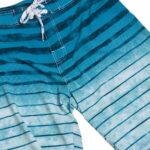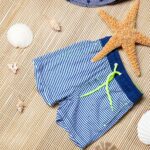What to Wear in Germany in Summer
For those planning a visit to Germany during summer, having the proper clothing is essential. Understanding what to wear during this season will allow you to enjoy the sights and activities without being uncomfortable or overdressed.
- Comfortable Footwear: Opt for comfortable shoes with good grip, as you may walk on cobbled streets or hike in the countryside.
- Breathable Clothes: Due to warm weather, light and breathable clothes made of natural materials are recommended.
- Sun Protection: Sunscreen lotion, sunglasses, and hats are important in preventing sunburns and staying cool under direct sunlight.
- Rain Gear: Although it’s summer, sudden rain showers can happen; pack a waterproof jacket or umbrella just in case.
- Swimwear: Have your favorite swimwear ready if visiting places with lakes, rivers or pools—beach towels are also practical.
It is worth noting that Germans have a high standard of dressing; avoid wearing something too revealing or beachwear on city streets. Instead, opt for trendy clothes that mirror the fashion trends in Germany.
As water fountains and public baths remain popular venues even among locals during summer heatwaves, observing cultural customs is important for an enjoyable experience.
During my stay in Rostock last August, I recall a trip to Neptun’s Nixe—a pond where locals bathe—with my friend Therevea. While preparing for our trip, she advised me not to forget my swimsuit and beach towel because we would be taking a dip later. It was an exhilarating experience with refreshing water contrasted by scenic views!
Summer in Germany is so hot, you’ll need lighter fabrics than a politician’s promises.

Light Fabrics for Hot Weather
Clothing Options for Hot Summer Days:
When the temperatures soar during summer, finding comfortable clothing options becomes crucial. Apparel made from light fabrics that allow airflow and aid in sweat evaporation can make all the difference in keeping you cool and dry while preventing heat-related illnesses.
Key Points to Keep in Mind:
To beat the heat, consider the following light fabric options:
- Cotton: Known for its breathability, absorbency, and softness, cotton is an excellent fabric choice for hot weather.
- Linen: Lightweight and absorbent, linen is another must-have in your summer wardrobe.
- Rayon: This man-made fabric is a cheaper alternative to silk, but offers similar properties such as softness, breathability, and moisture-wicking abilities.
A Few Extra Tips:
For added cooling and comfort, avoid dark-colored clothing as they absorb more heat. Loose-fitting apparel, such as oversized dresses, wide-leg pants, and flowy tops, allows air to circulate around your body, creating a cooling effect that will keep you comfortable.
Practical Suggestions:
Consider wearing a lightweight, cotton sundress, a roomy linen blouse, or a flowy rayon shirt paired with breathable shorts or pants. Accessorize with a wide-brimmed hat, sunglasses, and breathable footwear to complete your summer look. Always opt for light-colored clothing as they reflect the sun’s rays, keeping you cooler and more comfortable in the heat.
Don’t sweat it, opt for cotton and linen clothes for a chill summer in Germany.
Cotton and Linen Clothes
Cotton and linen fabrics are ideal for scorching weather conditions. These textiles keep the body fresh and are incredibly durable. They offer an excellent breathable quality, making them a perfect choice in hot and humid climates.
- Both cotton and linen absorb moisture efficiently, enabling perspiration absorption from your body.
- Cotton does not cling to the skin while wet and absorbs moisture quickly and efficiently.
- Linen is a highly absorbent material having high levels of natural lustre, which provides an elegant look to clothing.
- Cotton and linen fabrics are soft-to-touch materials that do not irritate the skin even in hot weather.
- These materials can be washed easily with detergent using appropriate washing cycles.
- Cotton and Linen fabrics are environmentally sustainable options compared to other synthetic materials, thereby providing long-lasting comfort while preserving our planet.
Apart from their myriad benefits, these fabrics have one of the smallest carbon footprints among clothing options.
It’s a sunny day on a remote island off Thailand’s coast when Sandra wanders up the shoreline in search of sunglasses. She had lost them somewhere on her travels before deciding to head out for a walk. An old lady approaches her with some beautiful dresses made from cotton-linen blends. Sandra hesitated initially but was eventually persuaded by their beauty. For the rest of her trip, she wore those clothes comfortably in challenging temperatures and received compliments at every turn for her beautiful looks.
You can choose breathable sneakers or sandals for hot weather, but either way your feet will still smell like a garbage dump.
Breathable Sneakers or Sandals
Finding the right footwear during hot weather is essential to prevent sweaty feet and discomfort. Opting for comfortable, well-ventilated shoes can alleviate these issues. Here are six points to consider when selecting breathable sneakers or sandals.
- Choose shoes made of breathable materials like mesh or natural fabrics like cotton or linen.
- Sandals should be airy, with enough room for your toes to wiggle and your feet to breathe.
- Avoid closed toe shoes unless necessary, as they trap heat and reduce airflow.
- Look for shoes with moisture-wicking capabilities, which can keep your feet dry during humid weather.
- Consider shoes with perforated soles that allow for ventilation while walking or running.
- Try on different pairs to ensure a proper fit, as ill-fitting shoes can cause blisters and discomfort in hot weather.
It’s important to note that not all breathable footwear is created equally. Some options may be better suited for specific activities, while others may not provide enough support. Keeping these points in mind while selecting the right pair of ventilated footwear will ensure both comfort and practicality.
Throughout history, people have adapted their footwear based on the climate they lived in. Ancient civilizations like the Greeks and Egyptians wore sandals made of woven reeds or leather strips to combat heat. The Roman Empire introduced a type of sandal called “caliga” worn by soldiers, which made use of ventilation slits cut into its thick leather construction. Today’s modern versions have come a long way from ancient times but still retain much of their original design cues focused on creating comfortable and adequately ventilated foot protection for hot weather conditions.

Dress Code for Tourist Attractions
Germany is a country with a rich history and culture, which makes it a popular tourist destination. Tourist attractions in Germany require visitors to dress appropriately, adhering to a certain dress code. It is recommended to wear comfortable and breathable clothing, especially during summer. Clothing must cover the shoulders and knees when entering religious sites and places of worship.
Tourists are advised to wear comfortable and sturdy shoes for long walking tours. It is also essential to carry a sun hat, sunglasses, and sunblock to avoid sunburns. Lastly, avoid wearing revealing clothing, as it may be considered inappropriate in certain locations.
Pro Tip: Make sure to check the weather and dress accordingly, as the weather may change suddenly. Why show off your skin when you can show off your respect for cultural and religious sites?
Modest Attire for Religious Sites
When visiting places of worship, it is important to dress modestly as a sign of respect for the religious site and culture. Appropriate attire includes clothing that covers shoulders, thighs, and chest. Visitors should refrain from wearing revealing or tight-fitting clothing. Additionally, hats and shoes may need to be removed before entering certain areas.
It is worth noting that dress codes can vary depending on religion and specific site rules. While some places may only require modesty in attire, others may require more traditional or conservative garments such as headscarves or long robes. It is recommended to research dress code guidelines before visiting any religious sites.
Visitors should also be aware of their behavior while at religious sites. Loud talking, taking photos without permission, and disregarding site rules can all be disrespectful.
Interestingly, many religious sites have a history of enforcing strict dress codes for visitors throughout the ages. For example, St. Peter’s Basilica in Vatican City has maintained a dress code since the 16th century to ensure visitors show proper respect while inside the holy building.

Protection from the Sun
As the sun can be intense during summer in Germany, safeguarding your skin is vital.
Applying sunscreen with high SPF levels, wearing a hat to shield your face and eyes, and staying in shaded areas during peak hours are effective ways to protect yourself from the sun’s harmful rays.
It is important to note that not all sunscreens are created equal, and choosing one with broad-spectrum protection and water resistance is crucial. Additionally, dark-colored clothing may absorb more heat, making it uncomfortable during hot weather, while light-colored, loose-fitting clothing can offer more breathability and help keep you cool.
My friend, who visited Germany last summer, did not take proper sun protection measures and ended up with a painful sunburn that ruined her trip. It is crucial to be vigilant and take necessary precautions to avoid such incidents.
Protect your skin and your eyes, unless you want to look like a tomato wearing shades.
Sunglasses and Sunscreen
Sun damage is a critical concern. It is essential to take precautionary measures to protect your skin and eyes from harmful effects. Combining the use of sunglasses and sunscreen can significantly reduce your exposure to the sun’s UV rays.
- Sunglasses provide vital protection against harmful UVA and UVB radiation, that can cause damage to the retina and lead to cataracts.
- Quality sunglasses with polarized lenses help reduce reflections that irritate our eyes when we are in bright sunlight conditions.
- Protection against harsh sunlight helps reduce the risk of skin cancer, wrinkles, and age spots that result from prolonged sun exposure.
- A high SPF sunscreen can prevent ultraviolet radiation from penetrating the skin, thereby reducing the risk of skin cancer or early aging due to excessive sun exposure.
- Sunscreen lotions with strong and long-lasting coverage offer better protection, making them ideal for long periods of outdoor activities like swimming or hiking.
- Caring about your health by avoiding unnecessary time in direct sunlight during peak hours (10 am – 4 pm) is beneficial.
UV radiation contact with an unprotected eye can lead to severe damage to eyelids and cornea. Therefore, it’s crucial to wear proper protective gear all year round.
Be it good preventive measures or terrible consequences; history tells us everything! People have learnt hard lessons throughout history: as they made a lot of hazardous mistakes per their airway safety in airplanes while travelling at height around noon when the UV-ray are never tolerable. Such instances remind us how important investment in protective gears is for our betterment-health wise!
A wide-brimmed hat not only protects you from the sun, but also makes you look like a glamorous movie star hiding from paparazzi.
Wide-brimmed Hats
Protecting yourself from harmful UV rays is essential when you’re out in the sun. One effective way to do so is by using headwear with wide brims, which play a crucial role in safeguarding your skin and eyes.
- Wide-brimmed hats offer adequate coverage for the face, neck and shoulders, reducing direct sunlight penetration on these sensitive areas.
- They come in various designs, providing style and functionality.
- These hats are made of lightweight materials that enhance comfort even when worn for extended periods.
So why not add a stylish touch to your wardrobe while protecting yourself from intense solar radiation? Invest in a wide-brimmed hat today.
A study published in the Journal of Investigative Dermatology discovered that wearing broad-brimmed hats are associated with reduced photodamage on skin surfaces.
Rain, rain, go away…and take my frizzy hair with you!
Knowing what to wear during summer in Germany is crucial to ensure comfort while exploring. Lightweight clothes made of breathable fabrics are recommended. Opt for neutral colors and add pops of color with accessories. A hat and sunglasses are a must to protect against the sun, while comfortable walking shoes can take you further. Additionally, be prepared for sudden changes in weather by bringing layers and a lightweight rain jacket. Remember to always dress modestly when visiting churches and other religious sites.



































